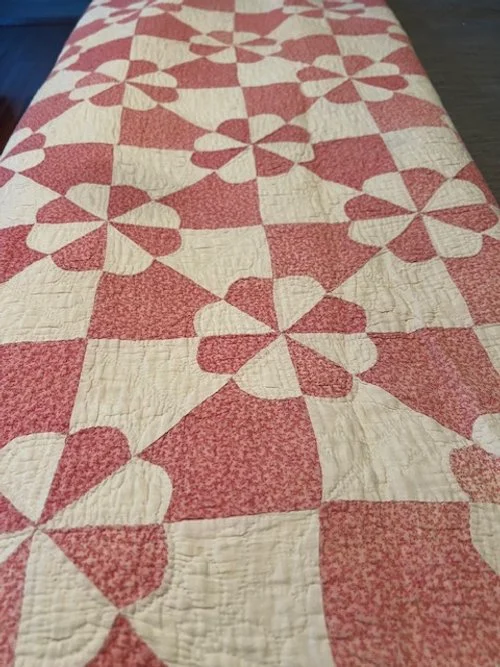GLENDA & MARTY’S DRESDEN (PART ONE)
I am a quilt, but not just any quilt. I may have been bled on, I may be tattered and torn, I may have lived many lives. But I am loved.
Glenda and Marty Carbaugh graciously answered one of my calls for quilt stories. Part of our conversation follows:
“I can appreciate a beautiful quilt,” said Glenda Carbaugh, as she introduced me to her beautiful pinkish and white Dresden quilt that was passed onto her in a beautiful dark, honey colored cedar chest when she was first married. “It was 1977 and we got this entire cedar cabinet filled with everything…” The cedar chest came from Glenda’s husband Marty’s side of the family. His mother died when she was only 59. “I didn’t want to be the generation that let it…” she trails off, perhaps thinking that she may, in fact, be the last generation to care for the beautiful quilt and the rest of the cedar chest’s contents. She shows me the border that the woman who restored her quilt cut off. It is heavily stained with something that looks like dried blood. “When I was having it restored, we got into a bit of a deep dive of trying to figure it out.”
Glenda & Marty consider themselves stewards of this beautifully hand-stitched Dresden Plate Quilt (photo courtesy of Glenda Carbaugh)
She gingerly removes a fragile scrapbook from the cedar chest. “What we know about this scrapbook… it was started partly from the World’s Fair in Chicago in 1893.” She shows me images that may be from the World’s Columbian Exposition in Chicago, like the Fisheries Building and the Hall of Mines and Mining, all of which were torn down after the fair. Marty notes that all the buildings were painted white, an interesting fact that they discovered in their research and which Glenda says the book, The Devil in the White City is based. Many, many more books would be and still are being written about this monumental event. She tells me later with some astonishment that about 25% of the world’s population attended the fair; the equivalent of about 27 million people (one estimate in 1800 shows the world’s population at about 1 billion. That would grow to 2.2 billion by 1938). “We can’t even fathom how important this fair was. The railroads were nearby, new inventions, everything new that was happening,” Glenda says a little breathlessly. This fair, Glenda tells me later, was a celebration of the 400th anniversary of Christopher Columbus’s arrival in the America’s.
Further in the scrapbook, she finds a merit award for an Arthur Robertson. The Robertson name became a touchstone in her research as she learned about Josephine Robertson, the first wife of Marty’s stepdad, George. Glenda goes on to say, “I probably loved the quilt a lot from the beginning. I’m a 19 year-old newlywed with no household goods.” She tells me they were the only of his siblings in that position as Marty’s other siblings were already established in their marriages and homes. Marty’s parents died in a fire in 1978 and by their first anniversary, Marty and Glenda were transferred to Minnesota, Glenda had to have knee surgery, and she had a high-risk pregnancy. Their son was born in 1980. “Our life was happening fast and furious.” (And as Glenda recalls all of this, she exclaims from her kitchen, “bring it on!” with the roar of a lioness).
Glenda thinks the Dresden Plate quilt belonged to George and Josephine. George had wealth and prestige and had married the daughter of a prominent pastor. An internet search revealed a lot about her family…
…visit my blog in June for the rest of Glenda and Marty’s quilt story!
If you have a quilt story to tell, please comment below. I want to hear it! And for those who are working on a quilt now, be sure to grab my book, The Story of Your Quilt. It’s a journal with plenty of motivational quotes and inspirational prompts to help tell your tale. You can find it here.
